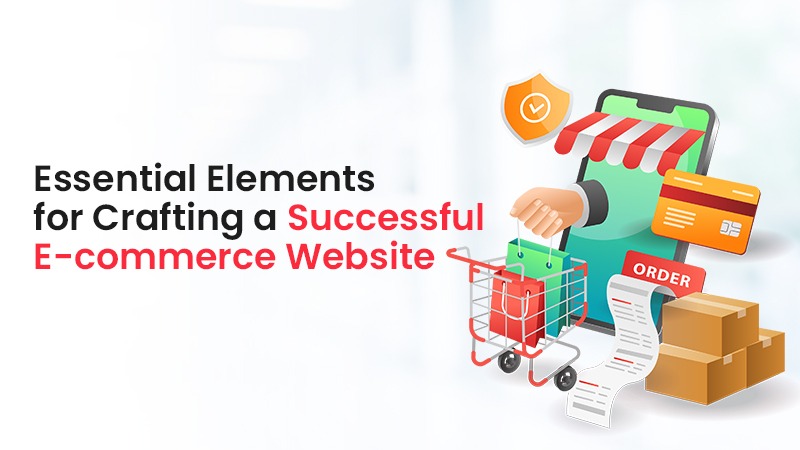In today’s digital age, having a strong online presence is crucial for any business, and for e-commerce ventures, a well-designed website can make all the difference. From seamless navigation to secure transactions, every element plays a pivotal role in shaping the user experience and driving sales. In this blog, we’ll delve into the key factors that contribute to the development of a successful e-commerce website, backed by data and statistics from reputable sources.
1) User-Friendly Interface
The first impression matters, and a user-friendly interface sets the tone for a positive browsing experience. A study by Adobe says that, 38% of people will stop engaging with a website if the layout or content is not attractive. Ensure easy navigation with clear categories, prominent search functionality, and intuitive design elements that guide users seamlessly through the site.
2) Mobile Responsiveness
With the increasing number of mobile shoppers, optimizing your website for various devices is non-negotiable. According to Statista, mobile commerce sales are expected to reach 72.9% of total e-commerce sales by 2021. A responsive design ensures that your site looks and functions flawlessly across smartphones, tablets, and desktops, catering to the diverse preferences of your audience.
3) Secure Payment Gateway
Security is the most important thing when it comes to online transactions. Research by Baymard Institute shows that 17% of consumers abandon their carts due to concerns about payment security. Implement a reliable payment gateway that encrypts sensitive information, providing customers with peace of mind while making purchases. SSL certificates and compliance with PCI DSS standards are essential for maintaining trust and credibility.
4) High-Quality Product Presentation
Captivate your audience with stunning visuals and detailed product descriptions. According to Forbes, 90% of consumers consider visual content to be the most influential factor in their purchasing decisions. High-resolution images, multiple angles, and informative content help customers visualize the product and make informed buying decisions, reducing the likelihood of returns and exchanges.
5) Fast Loading Speed
In today’s fast-paced world, nobody likes to wait. Google reports that 53% of mobile site visits are abandoned if pages take longer than three seconds to load. Optimizing the website’s loading speed minimizes bounce rates and keep visitors engaged. Compress images, leverage browser caching, and invest in reliable hosting to deliver lightning-fast performance that keeps customers coming back for more.
6) Search Engine Optimization (SEO)
Boost your visibility and attract organic traffic with strategic SEO techniques. According to Google, 71% of B2B researchers start their research with a generic search. Conduct keyword research, optimize meta tags, and create compelling content that resonates with your target audience. A well-optimized website ranks higher in search engine results, driving more qualified leads to your online store.
7) Efficient Inventory Management
Prevent stockouts and streamline operations with robust inventory management systems. According to Invesp, over 70% of consumers will go to a competitor if a product is out of stock. Real-time tracking, automated alerts, and synchronized data ensure optimal inventory levels, minimizing the risk of overselling and backorders.
8) Customer Reviews and Ratings
Build trust and credibility by showcasing customer feedback prominently on your website. According to Spiegel Research Center, product reviews can increase conversions by 270%. Encourage satisfied customers to leave reviews and ratings, providing valuable social proof that influences purchasing decisions and fosters a sense of community around your brand.
9) Seamless Checkout Process
Simplify the checkout process to reduce friction and minimize cart abandonment rates. The Baymard Institute reports that the average cart abandonment rate across all industries is 69.57%. Enable guest checkout, offer multiple payment options, and provide clear progress indicators to guide users through each step effortlessly. A hassle-free checkout experience enhances customer satisfaction and encourages repeat business.
10) Integration with Social Media
Harness the power of social media to expand your reach and engage with your audience on a deeper level. According to Ambassador, 71% of consumers who have had a positive experience with a brand on social media are likely to recommend the brand to their friends and family. Integrate social sharing buttons, showcase user-generated content, and leverage targeted advertising to drive traffic and conversions from platforms like Facebook, Instagram, and Twitter.
11) Responsive Customer Support
Deliver exceptional customer service with responsive support channels that cater to the needs of your audience. According to J.D. Power, 67% of customers have used a company’s social media site for servicing. Offer live chat, email support, and phone assistance to address inquiries promptly and resolve issues in a timely manner, fostering long-term relationships with your customers.
12) Regular Updates and Maintenance
Stay ahead of the curve with regular updates and maintenance to keep your website running smoothly. According to Kissmetrics, 40% of consumers will abandon a website if it takes more than three seconds to load. Monitor performance metrics, implement security patches, and incorporate user feedback to continually enhance the user experience and stay competitive in the ever-evolving e-commerce landscape.
In conclusion, a successful e-commerce website is built on a foundation of user-centric design, robust security measures, and strategic optimization techniques. By prioritizing these essential elements, you can create a compelling online shopping destination that delights customers and drives sustainable growth for your business.







